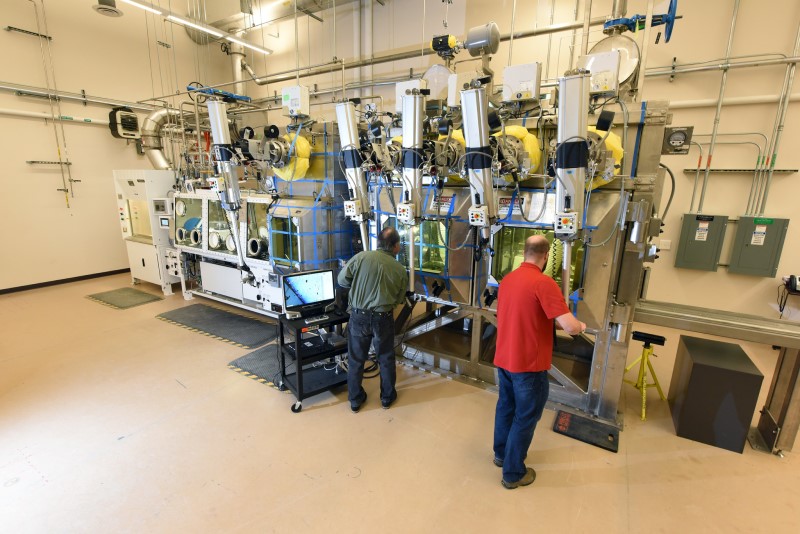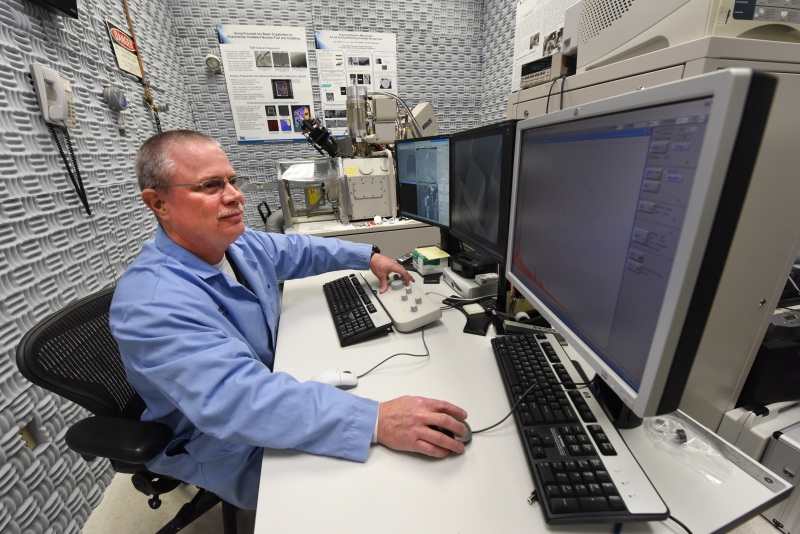NSUF Article
Materials and fuels find new life in NFML

Operated and managed by the Nuclear Science User Facilities (NSUF), NFML was initially conceptualized by the NSUF staff who identified an abundance of legacy materials from past research and development programs being stored without use in hot cells and laboratories across the country, including Idaho National Laboratory. However, thanks to NFML, over 6,000 individual samples are available for new or follow-on research.
“There’s a lot of valuable research material being stored in hot cells,” says NFML administrator Kelly Cunningham. “Over the years, we’ve added roughly 3,500 irradiated specimens as a result of NSUF sponsored projects.”
Unemployed materials and fuels that were utilized at one point in time all face the same problem: disposal. “If materials don’t have programmatic use, they’ll get disposed of,” says chief irradiation scientist Brenden Heidrich. “These materials represent tens of millions of dollars of research and development effort that would otherwise go to waste. They also represent not only a wide body of knowledge, but a huge savings to the government and taxpayer in that we don’t have to redo the work.”
The NFML also benefits researchers in the amount of time they save by having specimens readily accessible through the library. According to Heidrich, the process of irradiating and reproducing materials is lengthy, taking several years to accomplish, and may reproduce work that was already done. The purpose of NSUF nuclear energy research is to study materials and fuels that can be used in the powering of both commercial and noncommercial reactors in hopes of leading to further innovation in nuclear sciences, as opposed to repeating previous work, which only lengthens the process. “Saving them is pretty cheap. Redoing it is a lot more expensive,” says Heidrich.

Previously, researchers interested in studying materials used in experimental and commercial reactors would have to track down individual samples housed in different national laboratories around the nation, which is a lengthy and laborious operation in itself.
As a result of the creation of NFML, the process of obtaining materials has been streamlined. Interested parties access the library via NSUF’s website, find the individual sample they’d like to research and submit a proposal for approval. If a specific material isn’t available through NFML, or one they’d like to add to the library’s collection, researchers can submit their suggestions through a Request For Information available through the site. The NSUF requests information and/or suggestions on the potential additions to the NFML that can be produced through further irradiation tests.
Samples are physically located throughout the NSUF complex of partner institutions and are shipped between partner institutions as needed for NSUF-awarded research. Because these samples are stored at various facilities, each facility is responsible for compliance with individual state guidelines, restrictions and agreements relevant to the institution and state.
In the past year, NSUF has made several additions to NFML’s catalogue, including metallic fuel samples resulting from an NSUF project awarded to the University of Central Florida and stainless steel baffle bolts from commercial reactors. Both can be used in the innovation to make civilian power plants cheaper and safer.
As Heidrich and Cunningham reflect on the past year, they’re beginning to look toward the future. Aside from adding even more materials to the library, one of the most prominent projects the duo is working on moving into 2020 is a complete overhaul of NFML’s user interface to make it more accessible and intuitive.
In addition to making the library more congenial, NFML is hoping to begin supplying testing data found in prior studies of individual specimens, saving researchers both time and money in that they don’t have to conduct studies that have already occurred in the past. The availability of the information opens up avenues of partnership between researchers from around the world. “It enables collaboration,” says Heidrich. “You can find research projects that are of interest to you, the materials associated with that, where they were tested, the people that did it and their contact information so you can build a team entirely inside the NSUF structure.”
As the year draws to a close, NFML believes that the incorporation of testing data, coupled with the widespread availability of materials and centralization of information, will lead to a more safe and sustainable nuclear future.
Articles
About Us
The Nuclear Science User Facilities (NSUF) is the U.S. Department of Energy Office of Nuclear Energy's only designated nuclear energy user facility. Through peer-reviewed proposal processes, the NSUF provides researchers access to neutron, ion, and gamma irradiations, post-irradiation examination and beamline capabilities at Idaho National Laboratory and a diverse mix of university, national laboratory and industry partner institutions.
Privacy and Accessibility · Vulnerability Disclosure Program

